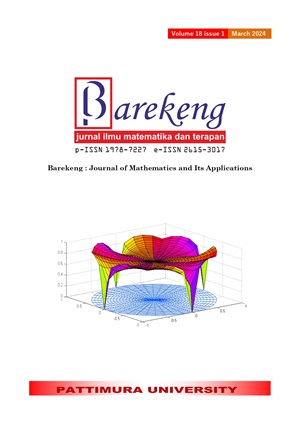RAINFALL FORECASTING WITH AN INTERMITTENT APPROACH USING HYBRID EXPONENTIAL SMOOTHING NEURAL NETWORK
Abstract
Rainfall forecasting is crucial in agriculture, water resource management, urban planning, and disaster preparation. Traditional approaches fail to capture complicated and intermittent rainfall patterns. The “Hybrid Exponential Smoothing Neural Network” is introduced in this study to handle intermittent rainfall forecasting issues. Exponential Smoothing, an established approach for discovering underlying patterns and seasonal fluctuations in time series data, is combined with Neural Networks, which are good at capturing complex linkages and nonlinearities. Using these two methods, this model hopes to deliver a complete rainfall forecasting solution that accounts for short-term changes and long-term patterns. This research uses residuals from the exponential smoothing model and is modeled using a Neural Network. The residual input is transformed using rolling mean. The results show that the hybrid model is able to capture patterns well, but there are still patterns that experience time lag. Experimental results obtained reveal that the hybrid methodology performs better than the model exponential smoothing, implying that the proposed model hybrid synergy approach can be used as an alternative solution to the rainfall time series forecasting. The results show that the Hybrid method can form patterns better than individual exponential smoothing models or neural networks. The RMSSE values for all areas are 1.0185, 1.55092, 1.0872.
Downloads
References
A. Qomaruddin Munir, H. Ismanto, and C. Author, “Rainfall Prediction Using Seasonal Autoregressive Integrated Moving Average and Geographic Information System,” vol. 9, no. 1, 2023, doi: 10.33480/jitk.v9i1.XXXX.
A. Muhaimin, D. D. Prastyo, and H. H. S. Lu, “Forecasting with recurrent neural network in intermittent demand data,” in Proceedings of the Confluence 2021: 11th International Conference on Cloud Computing, Data Science and Engineering, Institute of Electrical and Electronics Engineers Inc., Jan. 2021, pp. 802–809. doi: 10.1109/Confluence51648.2021.9376880.
A. L. S. Maia and F. de A. T. de Carvalho, “Holt’s exponential smoothing and neural network models for forecasting interval-valued time series,” Int J Forecast, vol. 27, no. 3, pp. 740–759, 2011, doi: https://doi.org/10.1016/j.ijforecast.2010.02.012.
S. Smyl, “A hybrid method of exponential smoothing and recurrent neural networks for time series forecasting,” Int J Forecast, vol. 36, no. 1, pp. 75–85, Jan. 2020, doi: 10.1016/j.ijforecast.2019.03.017.
M. Chattopadhyay and S. Chattopadhyay, “Elucidating the role of topological pattern discovery and support vector machine in generating predictive models for Indian summer monsoon rainfall,” Theor Appl Climatol, vol. 126, no. 1–2, pp. 93–104, Oct. 2016, doi: 10.1007/s00704-015-1544-5.
K. Sharma, “Classification of IRIS Dataset using Weka,” 2020. [Online]. Available: www.ijcait.com
J. L. de Biazzi, “Exponential smoothing for intermittent demand with demand basis updated more frequently than seasonality factors,” Gestao e Producao, vol. 26, no. 1, 2019, doi: 10.1590/0104-530X1297-19.
E. S. Gardner, “Exponential Smoothing: The State of the Art,” 1985.
M. Dekker, K. Van Donselaar, and P. Ouwehand, “How to use aggregation and combined forecasting to improve seasonal demand forecasts,” Int J Prod Econ, vol. 90, no. 2, pp. 151–167, Jul. 2004, doi: 10.1016/j.ijpe.2004.02.004.
I. Firmansyah and D. B. H. Hayadi, “Comparison of Relu and Tanh Activation Functions in Multilayer Perceptron,” Jurnal Informatika dan Komputer), vol. 6, no. 2, pp. 200–206, 2022.
Institute of Electrical and Electronics Engineers, 2019 International Conference on Robotics and Automation (ICRA) : Palais des congres de Montreal, Montreal, Canada, May 20-24, 2019.
F.-M. Tseng, H.-C. Yu, and G.-H. Tzeng, “Combining neural network model with seasonal time series ARIMA model.”
S. Panigrahi and H. S. Behera, “A hybrid ETS–ANN model for time series forecasting,” Eng Appl Artif Intell, vol. 66, pp. 49–59, Nov. 2017, doi: 10.1016/j.engappai.2017.07.007.
F. Azizi and W. C. Wibowo, “Intermittent Demand Forecasting Using LSTM With Single and Multiple Aggregation,” Jurnal RESTI (Rekayasa Sistem dan Teknologi Informasi), vol. 6, no. 5, pp. 855–859, Nov. 2022, doi: 10.29207/resti.v6i5.4435.
X. Zhuang, Y. Yu, and A. Chen, “A combined forecasting method for intermittent demand using the automotive aftermarket data,” Data Science and Management, vol. 5, no. 2, pp. 43–56, 2022, doi: https://doi.org/10.1016/j.dsm.2022.04.001.
A. T. Damaliana and S. Hidayati, “Implementation of Quantile Regression Neural Network Model for Forecasting Electricity Demand in East Java,” in 2022 IEEE 8th Information Technology International Seminar (ITIS), 2022, pp. 229–234. doi: 10.1109/ITIS57155.2022.10009045.
Copyright (c) 2024 Regita Putri Permata, Amri Muhaimin, Sri Hidayati

This work is licensed under a Creative Commons Attribution-ShareAlike 4.0 International License.
Authors who publish with this Journal agree to the following terms:
- Author retain copyright and grant the journal right of first publication with the work simultaneously licensed under a creative commons attribution license that allow others to share the work within an acknowledgement of the work’s authorship and initial publication of this journal.
- Authors are able to enter into separate, additional contractual arrangement for the non-exclusive distribution of the journal’s published version of the work (e.g. acknowledgement of its initial publication in this journal).
- Authors are permitted and encouraged to post their work online (e.g. in institutional repositories or on their websites) prior to and during the submission process, as it can lead to productive exchanges, as well as earlier and greater citation of published works.






1.gif)



